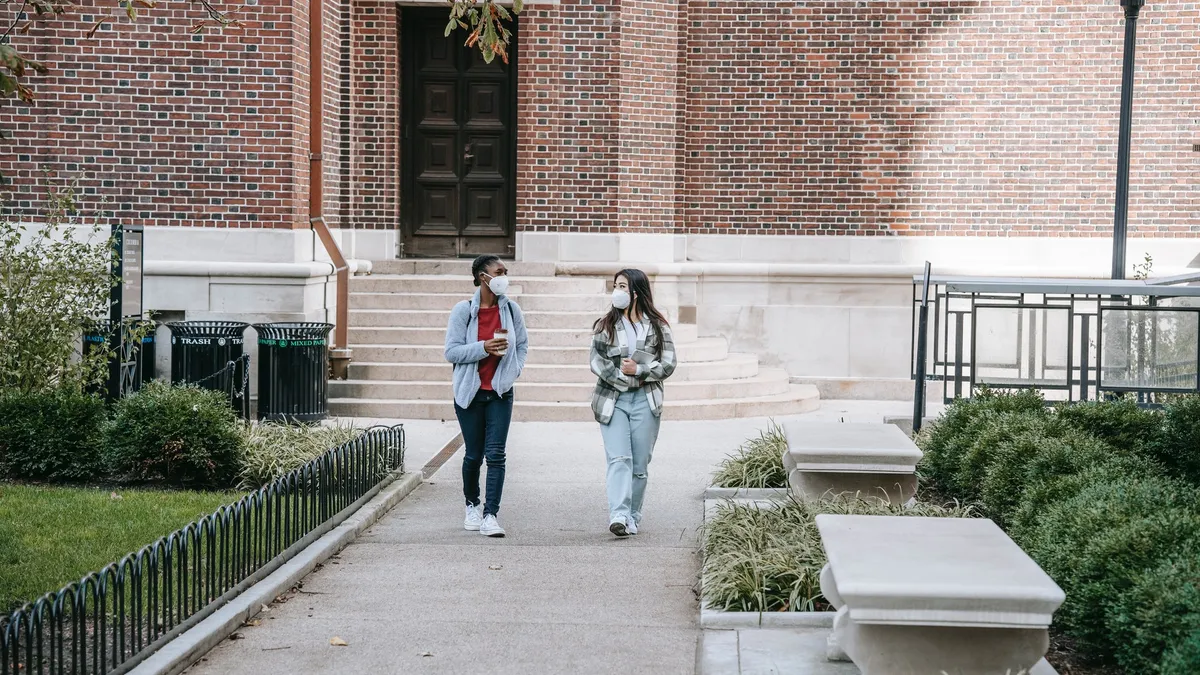Catalina Cifuentes had worked tirelessly to increase college-going among students in Riverside County, California, which ranked dead last among the major metropolitan areas in degree attainment in 2016. Over the course of six years, Cifuentes, the county's executive director of college and career readiness, helped grow Riverside's college enrollment rate by more than seven percentage points.
Then the coronavirus pandemic hit, and those hard-fought gains evaporated. This fall, 2,320 fewer students went straight from high school to college than did the year before. Nearly all of that loss was in community colleges.
Cifuentes' experience is not usual. Nationwide, the community college sector saw a 21% decline in first-time students this past fall. Preliminary data shows big decreases among students from low-income and diverse high schools like Riverside, where 65% of students qualify for free and reduced lunch.
Some would-be first-year students stayed home out of fear they'd contract the virus or spread it to vulnerable family members. Others stuck around to support siblings with online learning. And some chose to work after a parent was furloughed or had their hours cut.
Next fall isn't looking promising, either. Applications for federal financial aid, a key indicator of intent to enroll in college, are down across the country, and more than 40% of prospective students in one recent survey said they may delay starting a one- to two-year program. In California, where students had to submit the Free Application for Federal Student Aid by March 2 to be guaranteed a shot at state aid, applications for the Cal Grant were down several percentage points from the year before as of mid-April.
Now, with many state and school scholarship deadlines fast approaching or already passed, districts, colleges and higher ed access groups are scrambling to prevent a repeat of this year's enrollment decline and get the high school class of 2020 back on track.
The stakes are high. If first-year enrollment at two-year schools doesn't rebound next fall, not only will those colleges' finances suffer, but thousands of individuals could be left unqualified for the jobs expected to shape the post-pandemic economic recovery. Following the last recession, nearly all the positions created went to workers with at least some college education.
"They won't have an opportunity to break the cycle of poverty," said Kim Cook, executive director of the National College Attainment Network.
Here are four ways school districts, colleges and access groups can help ensure students enroll.
Talk to students
Counselors with the Riverside public school district are calling every 2020 high school graduate who didn't enroll in college this year to ask what kept them from doing so. The goal, Cifuentes said, is "to figure out what we did wrong in 2020 that we can fix in 2021."
They're finding some students were stymied by the matriculation process. After campuses closed last spring, community college advisers weren't answering their phones, and students didn't know where to turn for help, Cifuentes said.
"These are vulnerable students that were already on the fence about going, and you sealed the deal for them when you created these obstacles," she said.
At Pasadena City College, an hour down the road from Riverside, administrators created the Student Advisory Equipo (using the Spanish word for team) this fall, to give students a stronger voice in the institution's decision-making. Equipo members sit on college work groups and committees, offer feedback on projects under development and host online events celebrating Latinx culture, said Cynthia Olivo, vice president of student services.
Amid the isolation wrought by the pandemic, "our students are yearning for community and connection," Olivo said.
Go 'old school'
When the pandemic hit, most high schools and colleges shifted to virtual counseling. Chatbots and text message nudges replaced conversations in classrooms and offices.
But the technologies, which were catching on even before the pandemic, were no substitute for human interaction, Cifuentes said. With students taking their classes online, and some residing in other states or even Mexico, counselors struggled to cut through the noise and reach them.
"They're inundated with text messages and e-mails," she said. "They need a personal touch."
So this spring, Riverside's high school counselors are calling students after hours, asking if they need help filling out the Free Application for Federal Student Aid or figuring out the matriculation process.
"We're going back to old school phone banking," she said.
Sell yourself
Compared to their for-profit competitors, public colleges do very little marketing. For-profit colleges spend almost $400 on advertising per student, while private nonprofits spend $48 and public colleges spend just $14, a recent analysis of institutions that advertise found.
Community colleges, which operate on razor-thin margins, generally advertise the least of all.
"Community colleges think, 'We're in the community, students will come to us,'" Rufus Glasper, president and CEO of the League for Innovation in the Community College, told education reporters during a webinar in December.
Except this year, they didn't. Community colleges shed a fifth of their first-year students this fall, while for-profit, four-year colleges, many of which have been online for years, grew their first-time enrollment by nearly 10%, Clearinghouse data shows.
If community colleges hope to bring students back next fall, they'll need to come up with the funds to market themselves to students, Glasper said. "We have to treat community colleges as businesses."
Prove you're worth it
With many college classes still online, and the labor market months away from a full recovery, recent surveys and other reports show some students are asking whether a college degree is worth its cost.
To convince students that it is, colleges will need to create programs that respond to changing workforce needs, said Davis Jenkins, a senior research scholar at the Community College Research Center. They'll also need to smooth transfer pathways between associate and bachelor's degree programs, which tend to lead to higher earnings.
"Moving forward, you cannot be offering programs that do not lead either directly to a good job or to a bachelor's program," Jenkins said.
In Southern Nevada, where unemployment has climbed during the pandemic due to the region's dependence on tourism, the local community college is launching programs this fall to train displaced workers for emerging careers in health care and emergency response. The College of Southern Nevada is also embedding new information technology certifications in some of its degrees so students can "stop off and get a job if they need to," and return later to finish their program, said its president, Federico Zaragoza.
"We're re-engineering programs for a post-COVID era that is going to be a bit different," he said.
Back in Riverside, Cifuentes is not going down without a fight.
"I worked for years to get that momentum," she said. "I refuse to let it go."





















